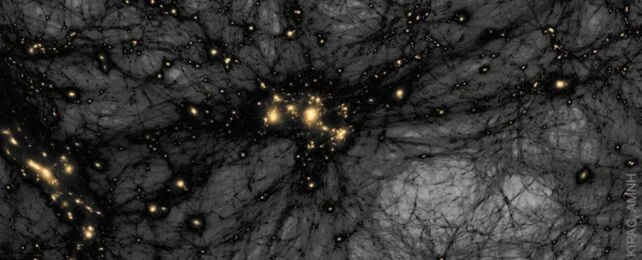
Evolving Dark Matter: A Revolutionary Theory to Solve the Universe’s Expansion Mystery
A groundbreaking new study suggests that dark matter, long believed to be a constant, might be evolving over time, potentially resolving the Hubble tension and reshaping our understanding of the universe. This revolutionary idea, recently published on arXiv, challenges the fundamental assumption that dark matter remains unchanged, a cornerstone of cosmology for decades.
The Hubble Tension: A Cosmic Puzzle
The Hubble tension represents a significant discrepancy in measuring the Universe’s expansion rate. Measurements from the cosmic microwave background (CMB) indicate a slower expansion, while local galaxy observations point to a faster rate. This mismatch has vexed cosmologists, leading to various proposals for new physics beyond the standard model.
The evolving dark matter model posits that if about 15% of dark matter evolves with a fluctuating equation of state (EOS), it could reconcile these conflicting measurements. This radically departs from previous theories focusing on evolving dark energy or alternative gravity theories.
What Does Evolving Dark Matter Mean?
Traditionally, dark matter has been considered “cold” and stable, meaning its fundamental properties don’t change and it interacts weakly with light. The new theory proposes that a fraction of dark matter could exhibit oscillatory behavior in its EOS, with its pressure and density relationship varying over time. This concept draws parallels with neutrinos, which undergo mass oscillations despite weak interactions.

The authors suggest that if cold dark matter particles share similar oscillatory properties, it could profoundly impact the formation and evolution of cosmic structures. The remaining 85% of dark matter would still behave traditionally, preserving the successes of existing observations.
Wormholes and Dark Energy: A Quantum Perspective
Another intriguing perspective explores the role of subatomic wormholes in driving the universe’s accelerated expansion. These microscopic tunnels, constantly created and destroyed due to quantum effects, could act as a form of dark energy. Tsilioukas suggests that if roughly ten billion wormholes form per cubic centimeter each second, their energy could fuel the universe's accelerating expansion.
Implications and Future Research
This evolving dark matter concept opens new avenues for explaining cosmological data discrepancies. It could shed light on expansion rate struggles and potentially suggest new particle physics phenomena. However, the study's authors acknowledge their model as a “toy” framework, not yet providing precise constraints on the nature of oscillatory dark matter particles.
Future observations, especially from large-scale surveys like DESI (Dark Energy Spectroscopic Instrument), are essential to testing these predictions. Confirming or refuting evolving dark matter could reshape our knowledge of the Universe’s past and future.
A Call for Open Minds
While evolving dark matter holds promise, it faces challenges. Current evidence is indirect, based on subtle fits to cosmological data rather than direct detection. The lack of direct dark matter particle observation remains a significant hurdle, and evolving dark matter adds complexity.
This hypothesis encourages scientists to expand models and consider dark matter’s dynamic behaviors. As cosmology enters a precision era with abundant new data, keeping an open mind is crucial.
What do you think about the possibility of evolving dark matter or the role of wormholes in the universe's expansion? Share your thoughts and theories in the comments below!